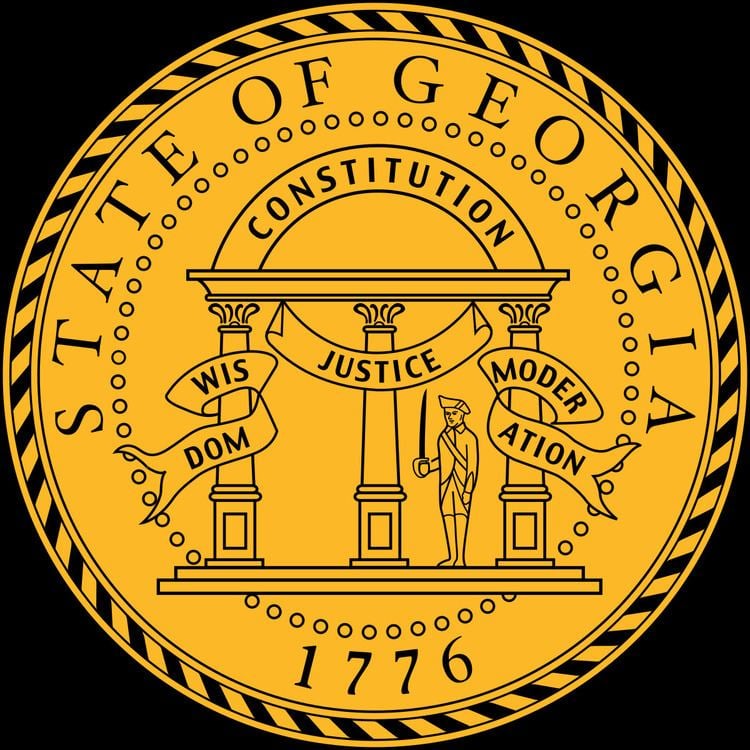Inaugural holder William Ewen
1775 | Salary $139,339 (2013) | |
 | ||
Residence Georgia Governor's Mansion Term length Four years, renewable once Formation Georgia State Constitution | ||
The Governor of Georgia is the head of the executive branch of Georgia's state government and the commander-in-chief of the state's military forces. The governor also has a duty to enforce state laws; the power to either veto or approve bills passed by the Georgia Legislature; the power to convene the legislature; and the power to grant pardons, except in cases of treason and impeachment.
Contents
The current governor is Nathan Deal. Governor Deal is only the second governor of Georgia from the Republican Party since the Reconstruction era.
Governors
For the period before independence, see the list of colonial governors of Georgia.Georgia was one of the original Thirteen Colonies and ratified the Constitution of the United States on January 2, 1788. Before it declared its independence, Georgia was a colony of the Kingdom of Great Britain. Like most early states, Georgia had claims to western areas, but did not cede its claims during the formation of the country like the other states. It sold this area, the Yazoo Lands, to the federal government on April 24, 1802, when it was assigned to Mississippi Territory.
In Georgia's Rules and Regulations of 1776, considered by some to be the first constitution, the chief executive was a president chosen by the legislature every six months. This was quickly superseded by the 1777 constitution, which called for a governor to be chosen by the legislature each year, with a term limited to one year out of every three. In the event of a vacancy, the president of the executive council acted as governor. The governor's term was lengthened to two years in the 1789 constitution. The 1798 constitution modified succession so that the president of the senate would act as governor should that office become vacant. An 1818 amendment to that constitution extended the line of succession to the speaker of the house, and an 1824 amendment provided for popular election of the governor.
While the 1861 secessionist constitution kept the office the same, the other constitutions surrounding the American Civil War brought lots of changes. The 1865 constitution, following Georgia's surrender, limited governors to two consecutive terms of two years each, allowing them to serve again after a gap of four years. The Reconstruction constitution of 1868 increased the governor's term to four years. The 1877 constitution, after local rule was re-established, returned the office to the provisions of the 1865 constitution. An amendment in 1941 lengthened terms to 4 years, but governors could no longer succeed themselves, having to wait four years to serve again. The constitution does not specify when terms start, only that the governor is installed at the next session of the General Assembly.
The 1945 constitution provided for a lieutenant governor, to serve the same term as governor and to act as governor if that office became vacant. Should it become vacant within 30 days of the next general election, or if the governor's term would have ended within 90 days of the next election, the lieutenant governor acts out the term; otherwise, a successor is chosen in the next general election. This was retained in the 1976 constitution. The current constitution of 1983 allows governors to succeed themselves once before having to wait four years to serve again, and lieutenant governors now become governor in the event of a vacancy. Should the office of lieutenant governor be vacant, the speaker of the house acts as governor, and a special election to fill the office must happen in 90 days.
The revolutionary government had several names and schisms, and it is unknown who should have been considered the chief executive at various times. This article ignores the Council of Safety in favor of Archibald Bulloch, considered by many to be the first governor of Georgia.
No party (15) Military (1) Democratic-Republican (16) Democratic (41) Whig (2) Republican (4) Constitutional Union (1)
Other high offices held
This table lists congressional seats, other federal offices, and Confederate offices. All representatives and senators mentioned represented Georgia. * denotes those offices which the governor resigned to take.
Living former governors
There are five living former governors, the oldest being Jimmy Carter (served 1971–1975, born 1924). The governor to die most recently was Carl Sanders (served 1963–1967, born 1926), on November 16, 2014; the most recently serving governor to die was George Busbee (served 1975–1983, born 1929), on July 16, 2004.
